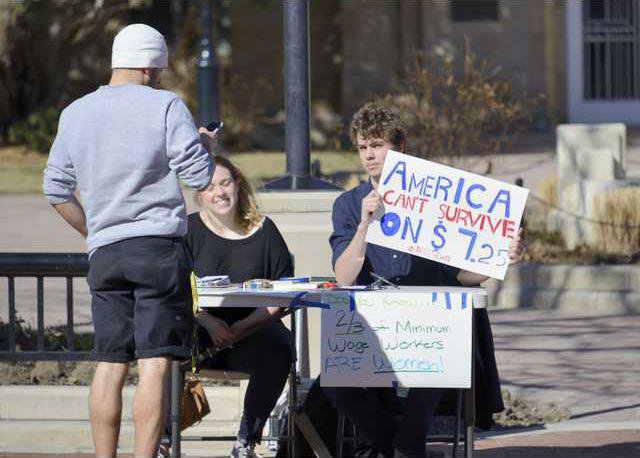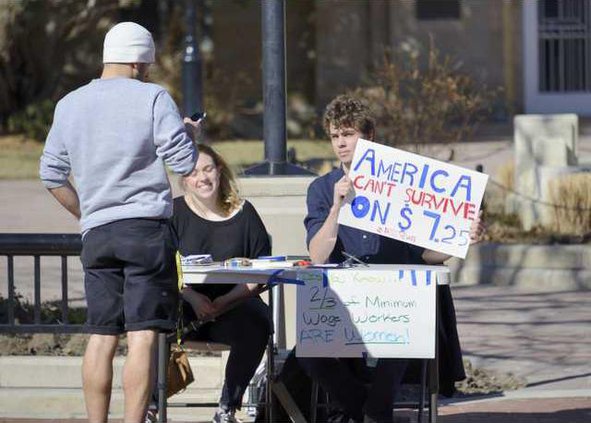Like many small business owners, Scott Huish believes he has a special role in his community of Tukwila, Wash. His Family Fun Center largely employs local teenagers, offering them the minimum wage for their first real job.
"Parents tell their friends who then tell their friends (to encourage teenagers to apply)," Huish said. "We do a lot of first-time job training."
Unfortunately for the amusement park's young workers, annual increases to Washington's state minimum wage have gradually reduced the amount of available hours. At $9.32 per hour, Washington's mandated minimum is the highest in the nation, adjusting each year for inflation, according to the BrookingsInstitution.
"We have altered our hours to open later and close earlier, because of the fact that (the minimum wage) is so high," Huish said. He also began ordering pre-rolled pizza dough balls, saving the cost of having cafe workers come in early.
Although such adjustments can be seen as efficient streamlining in a business operation, Huish characterizes them as part of the untold story of the ongoing minimum wage debate. While he worries about how to stay competitive and provide worthwhile jobs for first-time workers, national coverage of the issue predominately focuses on a popular narrative pitting unfeeling economists and employers against the men and women attempting to support their families on less than $10 per hour.
Raising the minimum wage has become a populist issue in America, a cure for poverty and income inequality that captures the hearts of people who view an increase as inherently good, explained Jared Pincin, an economics professor at The King's College. A new study from Public Religion Research Institute found that, "69 percent of Americans support increasing the (federal) minimum wage from $7.25 to $10.10." A breakdown of those supporters showed 90 percent were black, 83 percent were Hispanics and 62 percent were white Americans.
But raising the hourly pay for a fraction of America's workers will do little to solve economic woes that affect the nation's working poor, some economists argue, while actually limiting employment opportunities for businesses like Huish's.
"At a political level, the minimum wage debate has become a question of, 'Do you want to help poor people or not?’ ” said David Talcott, Pincin's colleague and writing partner at King's. "When you look at the economics of it, that's a horrible way to think about it."
Popular narrative
PRRI's research showed that fully two-thirds of Americans (66 percent) believe that the country is not doing enough to support people at the bottom of the economic ladder — a 6 point increase from 2012.
"We are living in a time when it is very difficult to live the dream of middle-class America," said Michael Santoro, a business ethicist and professor at Rutgers. "Is minimum wage the answer to this problem? No, certainly not by itself."
However, Santoro's conclusion is not as obvious to the majority of Americans who support a minimum wage increase, many of whom are captivated by this year's widespread fast-food-worker strikes.
Instead of the teenagers making pizzas or supervising rides at Huish's Family Fun Center, advocates for raising the minimum wage tell the story of people like Latoya Caldwell, a Wendy's worker "raising four children alone on $7.50 an hour," who was interviewed by NBC News in early September.
Caldwell is part of the popular narrative that has successfully put a face on an issue that, in the past, was often just about dollars and cents. But, as in the case of many emotion-based arguments, the face doesn't always reflect the facts.
Pincin, Talcott, Santoro and others don't question that many Americans are finding it difficult to make ends meet, and applaud the growing
sense that an extreme imbalance in income distribution hurts everyone. Yet they assert that the current debate isn't offering a fair picture of what's made possible through a minimum wage increase.
"We want to help people who don't have much to have a little more," said Talcott. "But that's not a very comprehensive way to think about what's going on with the minimum wage."
Who gets helped?
The problem with the minimum wage debate is that it misrepresents the group of Americans served by it, Pincin explained.
"The goal of the minimum wage is always painted as trying to help the least among us. And that's a great goal," he said. "But the minimum wage only affects around 4 percent of U.S. workers (paid by the hour) and almost a quarter of them are teenagers."
A recent factsheet from Pew Research Center portrayed the workers who earn the minimum wage each year. Using data from the Bureau of Labor Statistics, Pew noted that this group is disproportionately young, mostly white and largely composed of part-time workers, reflecting the profile of Huish's workforce of nearly 130 employees at The Family Fun Center.
The BLS data showed that 50.4 percent of workers paid at or below the minimum wage are ages 16 to 24, 77.4 percent are white and nearly half are white women. Additionally, 64.4 percent of the group only works part-time.
"Last year, 1.532 million hourly workers earned the federal minimum of $7.25 an hour; nearly 1.8 million more earned less than that because they fell under one of several exemptions (tipped employees, full-time students, disabled workers and others), for a total of 3.3 million hourly workers at or below the federal minimum wage," Pew reported.
The group represents 4.3 percent of America's hourly paid workers and 2.6 percent of the total workforce, Pew explained.
Rather than deny the legitimacy of this analysis, advocates for a minimum wage increase shift the focus from the population earning $7.25 an hour to a larger pool of so-called low-wage workers.
Paul Sonn, legal co-director of the National Employment Law Project, which runs the "Raise the Minimum Wage" campaign, said that to focus only on the 1.5 million workers described by Pew is to miss the true impact of the current $7.25 per hour minimum wage.
"Because the current minimum wage is so very low, very few workers earn it and that group is disproportionately young," he said. "The correct focus is instead on the much larger and older group of workers who would receive a raise if the minimum wage were raised to a more adequate level."
However, Huish has had a different experience. The annual minimum wage adjustments in Washington have put a strain on relationships with longer-term employees.
"When base employees see an increase, supervisors and crew leaders wonder what we can do for them," Huish said, but the budget for raises and bonuses keeps shrinking. He understands that advocates for an increase want to help workers, and he does too, but in ways that are more sustainable for his small business.
"Every year when I look at (earnings) at the end of the busy season, I ask, 'How much do I have?' 'How much can I give out?,’ ” he said. "If I have the money, I can give out summer bonuses. If I don't, I can't."
Targeted solutions
The subtle shift by advocacy groups from minimum-wage earners to low-wage workers in general is problematic when, as Pincin noted, the public already has a murky understanding of who is actually impacted by the minimum wage.
"If what you're trying to do is help those with a low income, you need a targeted approach," Pincin explained. "The minimum wage is not that targeted approach," because it primarily impacts teenage workers and their employers.
Talcott said a more effective alternative to helping working poor families is an expansion of the Internal Revenue Service's Earned Income Tax Credit program for poor families.
"By creating a refundable tax credit for families under certain (salary) thresholds, you could target who you want to target," he said.
Another potential solution that targets a specific group, Pincin said, is direct wage subsidies. Like the tax credit, this subsidy could be directed at low wage workers, supplementing people's earnings without putting pressure on small businesses.
A 2010 research paper from The European Commission on Employment, Social Affairs and Equal Opportunities reported that wage subsidies can improve the labor market during periods of recession. Government funds are channeled to business owners to either supplement the paychecks of current workers or finance new jobs.
Pincin explained that while wage subsidies have seen successful in Europe, such a policy would likely face stiff political resistance in the U.S. Congress. As the American Enterprise Institute reported in 2013, the program has few fans on either side of the aisle, since Democrats don't want to expend political energy on a program that is unattractive to Republicans and unfamiliar to voters.
Although not as simple or popular as increasing the minimum wage, economists argue that policies directly affecting a particular group of American workers would get closer to solving problems of financial stress for working families than a minimum wage increase.
"The problem of (income) inequality in America has become so deep and affects so many families. There's a general sense that we need to do something," Santoro said. "The minimum wage debate is where we wound up, but it shouldn't be the only focus of our efforts to make the lives of working people better."
Email: kdallas@deseretnews.com Twitter: @kelsey_dallas





